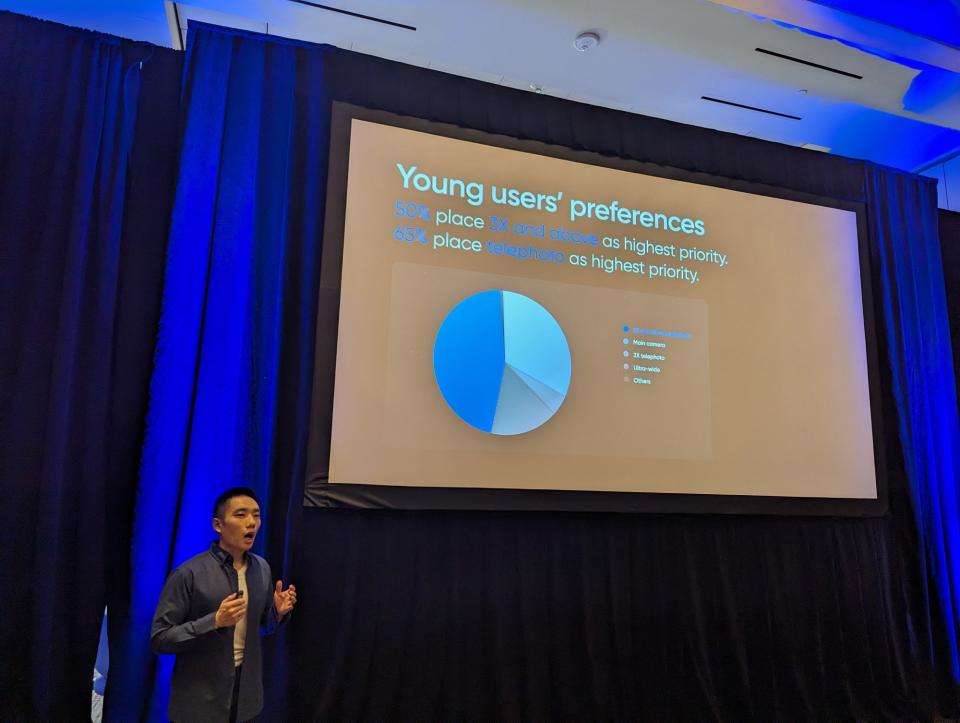CES 2024: China smartphone brand Realme unveils new handset on sidelines of trade show as its biggest rivals stay home
Chinese smartphone maker Realme, owned by mainland consumer hardware giant BBK Electronics which also controls Oppo and Vivo, held a parallel event in Las Vegas on the sidelines of the CES trade show to unveil its new handset as part of a rebranding effort targeting young overseas users.
While not an official exhibitor at CES, Realme was one of only two major Chinese smartphone brands to show up in Las Vegas this week. On Wednesday, Realme introduced its 12-series smartphones at the same hotel where its sister brand, OnePlus, had a series of suites booked for its own presentations outside CES.
Realme said its latest 12 Pro+ handset has the largest sensor in any periscope lens on a smartphone sold globally, but pointed out that the company's GT 5 Pro handset sold in China technically has a bigger sensor.
Do you have questions about the biggest topics and trends from around the world? Get the answers with SCMP Knowledge, our new platform of curated content with explainers, FAQs, analyses and infographics brought to you by our award-winning team.
"What sets us apart from other brands is that we are fully committed to the young generation," Sam Cheung, senior marketing communications manager for Realme, said in his presentation during the firm's hour-long event on the sidelines of CES 2024. "At Realme, we believe that every user at every price segment deserves an outstanding product."

Realme senior marketing communications manager Sam Cheung points out that the zoom capabilities of the firm's new 12 Pro+ smartphone's periscope lens are important to its young users. Photo: Matt Haldane alt=Realme senior marketing communications manager Sam Cheung points out that the zoom capabilities of the firm's new 12 Pro+ smartphone's periscope lens are important to its young users. Photo: Matt Haldane>
Realme, which did not reveal pricing for its latest handsets, said the chipset used in the 12 Pro+ will not be made public until closer to its formal launch. While the new device uses a mid-tier Qualcomm processor, Realme said it collaborated with the US chip design firm on a solution to improve image-processing speed.
The 11 Pro+ smartphone launched by Realme last year costs 2,799 yuan, or about US$400.
At its event, Realme said the firm's slogan, "Dare to leap", has been changed to "Make it real" as part of a rebranding effort.
The company said it was focused on a niche market segment, where it has found success overseas at a time when global smartphone sales are slumping and China's post-pandemic economic recovery has sputtered.
Realme acknowledged challenges from the pandemic, component shortages and longer replacement cycles from consumers, but the firm also touted its sales numbers - more than 200 million handsets sold since its incubation at Oppo - as "giving us confidence that we're on to something".
Moving forward, Realme aims to double down on what it believes young users want most in a smartphone. The answer it came up with is better photos when zooming in. So the firm has combined a half-inch sensor with a 3x optical zoom periscope lens and built that in its mid-tier line of smartphones.
It also collaborated with watch designer Ollivier Saveo, who previously worked at Rolex and Piaget, among others, on a design evocative of famed Swiss watches.
At a time of rising scrutiny of all things Chinese, Realme made its latest product announcement in a country leading the charge against tech from China and where the company does not even sell smartphones.
For all the other missing Chinese brands - and the smattering of journalists and influencers who showed up to cover the Realme event - it may as well have been part of the show. Vivo and Oppo, two of China's biggest smartphone brands, were nowhere to be found in Las Vegas, even though Realme spun out of Oppo. OnePlus, the Oppo-owned brand, had suites booked for private showings, but also had no presence on the CES exhibition floor.
Neither Xiaomi nor US-blacklisted Huawei Technologies were at CES.
Realme said it did not exhibit at CES because the 12 Pro+ handset has not officially launched yet. It organised a pre-briefing in Las Vegas because many of its contacts across a variety of markets would be in town for the world's largest consumer electronics show.
While the company set a goal last year of selling in more than 100 markets over the next five years, the United States is one market where it may not expand owing to the complexities of getting domestic network carrier support.
The bulk of US handset sales still happen through mobile network operators, forcing smartphone brands to strike deals to find success. OnePlus has struggled with this situation, despite the glowing reviews received by many of its devices from US tech media.
Realme said it was still trying to cooperate with a US carrier to get into the market, where 87 per cent of teenagers own an iPhone, according to a survey by investment bank Piper Sandler.
Meanwhile, Realme has been selling in parts of Europe and Latin America, which it described as an important market for the company's upcoming 12-series handsets.
This article originally appeared in the South China Morning Post (SCMP), the most authoritative voice reporting on China and Asia for more than a century. For more SCMP stories, please explore the SCMP app or visit the SCMP's Facebook and Twitter pages. Copyright © 2024 South China Morning Post Publishers Ltd. All rights reserved.
Copyright (c) 2024. South China Morning Post Publishers Ltd. All rights reserved.

 Yahoo Finance
Yahoo Finance 